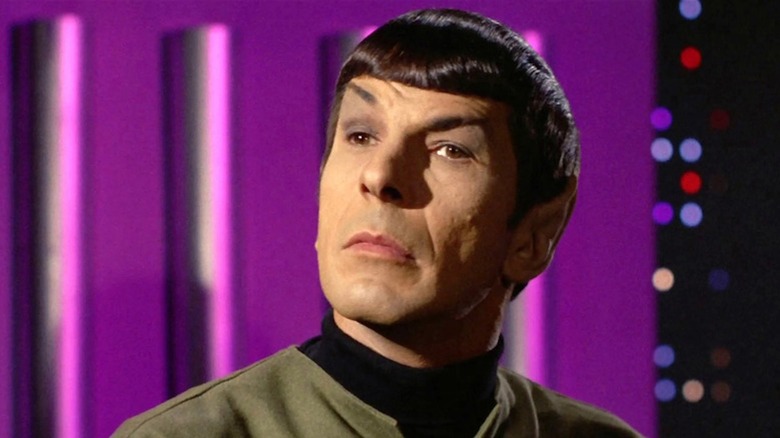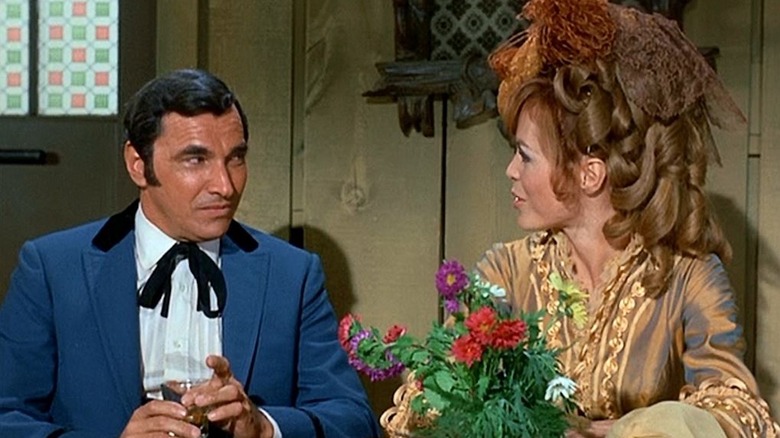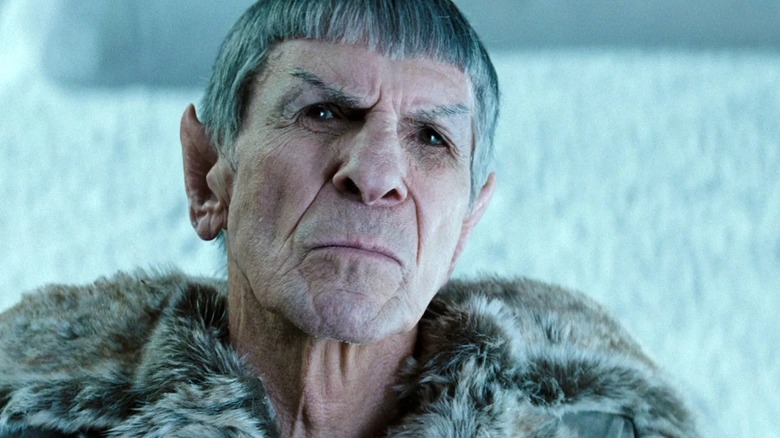Star Trek's Spock Shares An Unlikely Connection To A 60s Western Comedy
If you're a hardcore fan of a long-established science fiction series, you likely fall into one of two camps: you're either a purist who stays within the parameters of what's considered canon, or you're so ravenous to explore every nook and cranny of your favorite fictional universes that you happily step outside of canon and read spinoff novels and comic books that serve as what-if riffs on the established narrative. If you're the latter type of fan, you've got to have a high tolerance for go-nowhere yarns that add little of value to the franchise. But sometimes, in tearing through these non-canonical works, you hit upon a gem.
In 1985, Pocket Books published a slender "Star Trek" novel titled "Ishmael." This book fell between "Star Trek III: The Search for Spock" (which killed a Khan spinoff) and "Star Trek IV: The Voyage Home," and anticipated the narrative of the latter with a time-travel plot that finds Spock stuck in 1860s Seattle, Washington, where he must thwart a Klingon mission that, if successful, would wipe out the United Federation of Planets before it ever had a chance to exist. It's a funky little novel, but it worked well enough for fans and the minders of the "Star Trek" store that one aspect of it became canon. That it did so by wedding Gene Roddenberry's universe with another, very different 1960s television series with a minor "Trek" connection made it something of an off-canon classic.
When Star Trek met Here Come the Brides
If you're an avid reader of science fiction and fantasy novels, or if you've simply spent any amount of time perusing these aisles at your local bookstore or library, you're no doubt familiar with the name Barbara Hambly. She's a prolific genre author responsible for series like "The Darwath Trilogy," "Sunwolf and Starhawk" and "Winterlands," and she's also dabbled in both the "Star Trek" and "Star Wars" expanded universes. She's a well respected writer in her field, and shows no signs of slowing down at the age of 73.
When she wrote "Ishmael," the "Star Trek" franchise had attained a level of mainstream popularity that had eluded it since "The Original Series" debuted on NBC in 1966, and it had done so by foregrounding the death and rebirth of its most popular character, Spock. Writing a novel about Spock made sense. Sending him back to the 19th century Pacific Northwest by way of a long-canceled ABC Western comedy, however, seemed a bit of a stretch.
And yet there was a method to Hambly's madness. The series in question, "Here Come the Brides," which starred Robert Brown as a logging honcho who seeks to assuage the loneliness of his male employees by importing 100 eligible bachelorettes out west, premiered in 1968 and, despite mostly enthusiastic reviews, lasted a scant two seasons. What does any of this have to do with "Star Trek"? In the show, Brown's business foe is a sawmill owner who's made a hefty wager that this audacious companionship scheme will prove to be a loser. This character's name is Aaron Stempel, and he was played by Mark Lenard, who played Spock's father Sarek in "Star Trek: The Original Series," "Star Trek: The Animated Series" and three of the films.
In "Ishmael," Stempel is responsible for warding off an alien invasion of Earth during the 19th century, something the Klingons would very much like to occur. An amnesiac Spock is ultimately able to thwart the assassination of Stempel, and winds up back on the bridge of the Enterprise by the end of the novel.
It's a self-contained, non-canon adventure, but it did leave an imprint in official "Star Trek" lore.
Spock's full name is S'chn T'gai Spock
At the end of "Ishmael," Kirk reviews Spock's personnel record and discovers that his friend's mother, Amanda Grayson, bore the middle name of Stempel; ergo, she was a descendant of the sawmill owner whose life Spock saved in the distant past. In other words, Spock's mission wasn't just about saving the Federation; he also ensured his own existence. That's pretty heavy stuff for a non-canonical novel, and, evidently, the "Star Trek" braintrust liked Hambly's work enough that they decided to make a sliver of it canon.
That personnel record also lists Spock's full name: S'chn T'gai Spock. 24 years after the publication of "Ishmael," J.J. Abrams' "Star Trek" film entered this name into the Kelvin timeline canon; in 2022, "Star Trek: Strange New Worlds" made the name fully official.
As a canon-only fan of "Star Trek," if I'm going to allow non-canonical works to influence so much as an errant phaser blast in the official timeline, I choose to believe that Eddie Murphy revealed Spock's true full name to Halle Berry in the 1992 romantic comedy "Boomerang." In my mind, he is, and always will be, Spock Jenkins.


